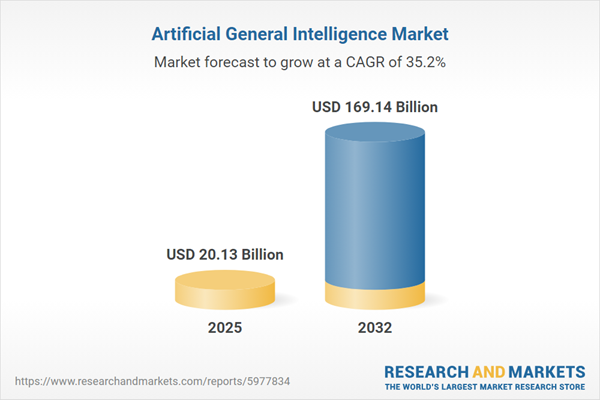Speak directly to the analyst to clarify any post sales queries you may have.
Artificial General Intelligence (AGI) is driving a major shift in enterprise technology, offering autonomous reasoning and advanced decision-making capabilities applicable across sectors. This report provides an in-depth examination for senior leaders considering investments or strategic positioning in this evolving landscape.
Market Snapshot: Artificial General Intelligence Market Growth and Outlook
The artificial general intelligence market grew from USD 15.17 billion in 2024 to USD 20.13 billion in 2025. This represents a compound annual growth rate (CAGR) of 35.17%, with expectations to reach USD 169.14 billion by 2032. The sector is driven by advancements in algorithmic theory, new system architectures, and increased interest from global organizations seeking to leverage AGI’s adaptive, scalable solutions. Industry verticals such as healthcare, finance, manufacturing, and retail are already piloting implementations as part of digital transformation strategies.
Scope & Segmentation of the Artificial General Intelligence Market
This comprehensive report thoroughly analyzes the artificial general intelligence market across primary segments and regions:
- Technology: Connectionist AI, Evolutionary AI, Neuromorphic Computing, Quantum-enhanced AI, Symbolic AI
- Offering: Models (Domain-Tuned, Open-Weight, Proprietary Closed), Platforms (Agent Orchestration, AGI Foundation, Governance & Observability), Services (Consulting & Advisory, Managed, Safety & Audit, Systems Integration, Training & Change Management), Tools (Evaluation & Safety, Plugins & Connectors, SDKs & APIs)
- Deployment Mode: Cloud-Based, On-Premises
- Enterprise Size: Large Enterprise, Small & Medium Scale Enterprise
- Application: Cognitive Work Automation, Creative & Media, Customer Experience, Cybersecurity, Data Analytics & BI, Education & Tutoring, Enterprise Intelligence, Financial Services, Healthcare, HR & Talent, Legal & Compliance, Personal Agents, Robotics & Embodied Intelligence, Scientific Discovery, Software Engineering, Supply Chain
- End-use: Defense & Aerospace, Education, Energy & Utilities, Finance, Healthcare, Legal Services, Manufacturing, Media & Entertainment, Retail, Scientific Research, Telecommunications, Transportation & Logistics
- Region: North America, Latin America, Europe, Middle East, Africa, Asia-Pacific
- Key Companies: Amazon Web Services, Salesforce, Alibaba Group, Anthropic, Apple, Baidu, C3.ai, Darktrace, Google, Graphcore, Hanson Robotics, Hyperscience, Intel, IBM, Meta, Microsoft, MindBridge Analytics, Mindtrace, Mistral AI, Neuralink, Numenta, Nvidia, Olbrain, OpenAI, Oracle, SAP, ServiceNow, Tempus AI, Tencent
Key Takeaways for Senior Decision-Makers
- AGI represents a paradigm shift, enabling automation of complex tasks that were previously domain-bound to human expertise.
- Algorithmic innovation and hybrid neuro-symbolic architectures are advancing AGI’s generalization and reasoning capabilities, offering a spectrum of solutions across diverse enterprise needs.
- Specialized hardware and evolutionary computing techniques are reducing compute overhead and supporting sustainable model scaling, addressing critical operational bottlenecks.
- Industry adoption varies by vertical: finance leads in predictive analytics; healthcare prioritizes regulatory-compliant deployments; manufacturing emphasizes operational efficiency and process innovation.
- Leading organizations are fostering robust ecosystems through cross-sector partnerships, investment in data governance, and strategic engagement with open-source and proprietary frameworks.
- Regional dynamics shape AGI adoption: North America and East Asia drive innovation hubs, while Europe and the Middle East focus on regulatory compliance and ethical standards.
Tariff Impact: Navigating Changing Supply and Regulatory Conditions
The 2025 introduction of new United States tariffs on critical components is already influencing global AGI supply dynamics. These measures are prompting technology providers to diversify procurement, seek alternative supplier networks, and accelerate local production where feasible. The response is fostering innovation in modularity and interoperability, especially as firms balance increased compliance costs and the need for agile supply chains. Open-source solutions and homegrown platforms are gaining traction as organizations adapt their strategies for uninterrupted service delivery and regulatory resilience.
Methodology & Data Sources
This study integrates primary research through interviews and surveys with key industry stakeholders, including AI practitioners, product managers, and regulatory authorities. Comprehensive secondary research incorporating leading academic sources, patent filings, and industry white papers supports the analysis to ensure reliable, empirically validated conclusions.
Why This Artificial General Intelligence Market Report Matters
- Provides an actionable foundation for capital allocation, technology partnerships, and risk management as AGI adoption accelerates across sectors.
- Equips decision-makers with segmentation insights, emerging trends, and regional context necessary to inform competitive strategies and responsible investments.
Conclusion
Artificial general intelligence is reshaping enterprise strategies and sector dynamics worldwide. This report offers senior leaders the clarity to evaluate, engage, and capture value in this rapidly evolving market.
Additional Product Information:
- Purchase of this report includes 1 year online access with quarterly updates.
- This report can be updated on request. Please contact our Customer Experience team using the Ask a Question widget on our website.
Table of Contents
3. Executive Summary
4. Market Overview
7. Cumulative Impact of Artificial Intelligence 2025
Companies Mentioned
The companies profiled in this Artificial General Intelligence market report include:- Amazon Web Services, Inc.
- Salesforce, Inc.
- Alibaba Group Holding Limited
- Anthropic PBC
- Apple Inc.
- Baidu, Inc.
- C3.ai, Inc.
- Darktrace Holdings Limited
- Google LLC by Alphabet Inc.
- Graphcore Limited
- Hanson Robotics Limited
- Hyperscience
- Intel Corporation
- International Business Machines Corporation
- Meta Platforms, Inc.
- Microsoft Corporation
- MindBridge Analytics Inc.
- Mindtrace Ltd.
- Mistral AI
- Neuralink Corp.
- Numenta, Inc.
- Nvidia Corporation
- Olbrain
- OpenAI LLC
- Oracle Corporation
- SAP SE
- ServiceNow, Inc.
- Tempus AI, Inc.
- Tencent Holdings Ltd.
Table Information
| Report Attribute | Details |
|---|---|
| No. of Pages | 191 |
| Published | November 2025 |
| Forecast Period | 2025 - 2032 |
| Estimated Market Value ( USD | $ 20.13 Billion |
| Forecasted Market Value ( USD | $ 169.14 Billion |
| Compound Annual Growth Rate | 35.1% |
| Regions Covered | Global |
| No. of Companies Mentioned | 30 |









